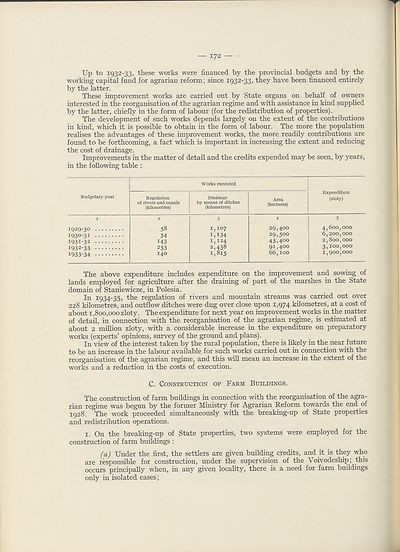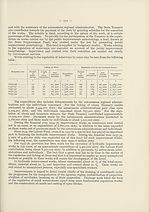Download files
Complete book:
Individual page:
Thumbnail gallery: Grid view | List view

Up to 1932-33, these works were financed by the provincial budgets and by the
working capital fund for agrarian reform; since 1932-33, they have been financed entirely
by the latter.
These improvement works are carried out by State organs on behalf of owners
interested in the reorganisation of the agrarian regime and with assistance in kind supplied
by the latter, chiefly in the form of labour (for the redistribution of properties).
The development of such works depends largely on the extent of the contributions
in kind, which it is possible to obtain in the form of labour. The more the population
realises the advantages of these improvement works, the more readily contributions are
found to be forthcoming, a fact which is important in increasing the extent and reducing
the cost of drainage.
Improvements in the matter of detail and the credits expended may be seen, by years,
in the following table :
Budgetary year
Works executed
Regulation
of rivers and canals
(kilometres)
Drainage
by means of ditches
(kilometres)
Area
(hectares)
Expenditure
(zloty)
1929- 30
1930- 3I
1931- 32
1932- 33
1933- 34
58
54
143
253
140
i,io7
i,i34
1,124
2,438
1,815
29.400
29,500
43.400
91.400
66,100
4,600,000
6,200,000
2,800,000
3,100,000
1,900,000
The above expenditure includes expenditure on the improvement and sowing of
lands employed for agriculture after the draining of part of the marshes in the State
domain of Staniewicze, in Polesia.
In 1934-35, the regulation of rivers and mountain streams was carried out over
228 kilometres, and outflow ditches were dug over close upon 1,974 kilometres, at a cost of
about 1,800,000 zloty. The expenditure for next year on improvement works in the matter
of detail, in connection with the reorganisation of the agrarian regime, is estimated at
about 2 million zloty, with a considerable increase in the expenditure on preparatory
works (experts’ opinions, survey of the ground and plans).
In view of the interest taken by the rural population, there is likely in the near future
to be an increase in the labour available for such works carried out in connection with the
reorganisation of the agrarian regime, and this will mean an increase in the extent of the
works and a reduction in the costs of execution.
C. Construction of Farm Buildings.
The construction of farm buildings in connection with the reorganisation of the agra¬
rian regime was begun by the former Ministry for Agrarian Reform towards the end of
1928. The work proceeded simultaneously with the breaking-up of State properties
and redistribution operations.
1. On the breaking-up of State properties, two systems were employed for the
construction of farm buildings :
(a) Under the first, the settlers are given building credits, and it is they who
are responsible for construction, under the supervision of the Voivodeship; this
occurs principally when, in any given locality, there is a need for farm buildings
only in isolated cases;
working capital fund for agrarian reform; since 1932-33, they have been financed entirely
by the latter.
These improvement works are carried out by State organs on behalf of owners
interested in the reorganisation of the agrarian regime and with assistance in kind supplied
by the latter, chiefly in the form of labour (for the redistribution of properties).
The development of such works depends largely on the extent of the contributions
in kind, which it is possible to obtain in the form of labour. The more the population
realises the advantages of these improvement works, the more readily contributions are
found to be forthcoming, a fact which is important in increasing the extent and reducing
the cost of drainage.
Improvements in the matter of detail and the credits expended may be seen, by years,
in the following table :
Budgetary year
Works executed
Regulation
of rivers and canals
(kilometres)
Drainage
by means of ditches
(kilometres)
Area
(hectares)
Expenditure
(zloty)
1929- 30
1930- 3I
1931- 32
1932- 33
1933- 34
58
54
143
253
140
i,io7
i,i34
1,124
2,438
1,815
29.400
29,500
43.400
91.400
66,100
4,600,000
6,200,000
2,800,000
3,100,000
1,900,000
The above expenditure includes expenditure on the improvement and sowing of
lands employed for agriculture after the draining of part of the marshes in the State
domain of Staniewicze, in Polesia.
In 1934-35, the regulation of rivers and mountain streams was carried out over
228 kilometres, and outflow ditches were dug over close upon 1,974 kilometres, at a cost of
about 1,800,000 zloty. The expenditure for next year on improvement works in the matter
of detail, in connection with the reorganisation of the agrarian regime, is estimated at
about 2 million zloty, with a considerable increase in the expenditure on preparatory
works (experts’ opinions, survey of the ground and plans).
In view of the interest taken by the rural population, there is likely in the near future
to be an increase in the labour available for such works carried out in connection with the
reorganisation of the agrarian regime, and this will mean an increase in the extent of the
works and a reduction in the costs of execution.
C. Construction of Farm Buildings.
The construction of farm buildings in connection with the reorganisation of the agra¬
rian regime was begun by the former Ministry for Agrarian Reform towards the end of
1928. The work proceeded simultaneously with the breaking-up of State properties
and redistribution operations.
1. On the breaking-up of State properties, two systems were employed for the
construction of farm buildings :
(a) Under the first, the settlers are given building credits, and it is they who
are responsible for construction, under the supervision of the Voivodeship; this
occurs principally when, in any given locality, there is a need for farm buildings
only in isolated cases;
Set display mode to:
![]() Universal Viewer |
Universal Viewer | ![]() Mirador |
Large image | Transcription
Mirador |
Large image | Transcription
Images and transcriptions on this page, including medium image downloads, may be used under the Creative Commons Attribution 4.0 International Licence unless otherwise stated. ![]()
| League of Nations > Communications and transit > Enquiry on national public works > (174) |
|---|
| Permanent URL | https://digital.nls.uk/195000612 |
|---|
| Shelfmark | LN.VIII |
|---|
| Description | Over 1,200 documents from the non-political organs of the League of Nations that dealt with health, disarmament, economic and financial matters for the duration of the League (1919-1945). Also online are statistical bulletins, essential facts, and an overview of the League by the first Secretary General, Sir Eric Drummond. These items are part of the Official Publications collection at the National Library of Scotland. |
|---|---|
| Additional NLS resources: |
|

